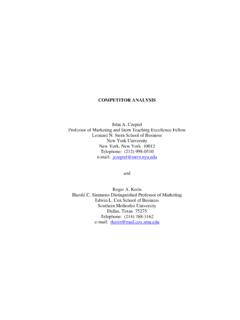Transcription of The recent evolution of the UK banking industry and some ...
1 The recent evolution of the UK banking industry and some implications for financial stability Alex Bowen, Glenn Hoggarth and Darren Pain 1. Introduction The UK financial system experienced significant structural change during the 1970s and 1980s. Before then the system was segmented. Different institutions existed to provide the differentiated services of commercial banking , investment banking , housing finance, life assurance, fund management and securities trading. Within the banking sector, there was a clear demarcation between clearing banks which provided commercial banking facilities and money transmission services largely to domestic customers, investment banks which provided a range of largely market intermediated financial services to both domestic and overseas corporate clients such as equity issuance and portfolio investment advice, and building societies which were the main source for housing finance.
2 These demarcations were maintained by various forms of official regulation such as exchange controls and lending constraints (including credit ceilings), which served to restrict competition and thus impart stability to the oligopolistic structure of the market. Changes to the institutional architecture took place progressively over the 1970s and 1980s. This was largely an evolutionary process, but a number of factors contributed to an intensification of competition and tended to erode the functional distinctions between firms. Five in particular are worth noting. First, the entry of foreign banks, associated with the continued growth in the eurodollar market and London's prominent role in this market, prompted the major clearing banks to expand their businesses into non-traditional markets such as corporate and unsecured lending.
3 Initially, this was typically achieved through acquisitions in order to circumvent existing credit control regulations. But deregulation in the form of competition and Credit Control (1971) and the abandonment of supplementary special deposits (the "corset") in the early 1980s eventually removed a number of barriers to the activities of the clearing The UK merchant banks were most affected by this increased competition from the traditional retail clearing banks and foreign banks, largely due to their small scale, which restricted their ability to compete for international capital projects/syndicated loans. Second, the removal of exchange controls in 1979 increased the global nature of competition .
4 Previously banks' domestic sterling activities were effectively ring-fenced from competition from overseas banks, including those foreign institutions already established in London. Again UK merchant banks perhaps bore the brunt of this increased internationalisation in their markets, as in particular the large US banks such as Citibank and Chase Manhattan, freed from their restrictions at home, expanded into wholesale and corporate banking in the United Kingdom. Third, in the early 1980s retail banks entered the domestic mortgage market, a market that had previously been dominated by the building societies. This increased competition led to the abandonment of the lending cartel in mortgages that had restricted prices and encouraged quantity rationing in the provision of housing finance.
5 It also encouraged banks and building societies to compete in other markets in which Specific changes in regulation have clearly influenced how the financial system evolved. The Appendix highlights the major regulatory changes that have affected banking over the past three decades (see Robb (1997)). In particular, the Building Societies Act (1986) increased the range of activities in which building societies were permitted to engage. But more generally, the changes in the financial system reflect an intensification of competition , not driven by deregulation alone. Indeed, some authors have argued that the process of deregulation through the 1970s and 1980s was largely a response to competitive pressures and financial innovation rather than a policy change designed to create greater competition (Llewellyn (1990), Fforde (1992)).
6 251 they had previously enjoyed significant market power, in particular retail deposits and money transmission services. Fourth, during the 1980s in particular, the financial system became more "market-oriented". Banks faced growing competition from other providers of savings media and credit financing for households as well as competition from capital markets for the provision of external finance to firms (Llewellyn (1990)). Finally, deregulation in the UK securities market in 1986 (the so-called "Big Bang") to remove restrictive practices in securities trading tended to bring the traditional banking system and the securities industry closer together and the functions performed by each institution have increasingly been merged.
7 Indeed, this reform encouraged a number of the large UK and overseas retail banks to build-up a presence in the securities markets in London through acquiring existing securities houses/investment banks. The upshot of these changes for the UK financial system was that by the end of the 1980s the traditional structure of specialist institutions had given way to a more conglomerate structure, at least in the retail banking market. Retail banking conglomerates attempted to learn the trade and techniques of investment banking and began to offer a wider range of services than traditional asset-liability transformation. And building societies, freed from regulatory barriers, began to compete with banks in unsecured lending and raise funds in wholesale markets.
8 Moreover, some large retailers ( Marks and Spencer) and large industrial companies ( British Petroleum) set up their own banking arms to compete with banks in supplying some traditional banking services. The UK investment/merchant banks, at least the ones that remained independent, continued to offer specialist services. Indeed, during the 1980s, the diversity of business structures increased with different firms adopting different strategies to compete in the increasingly global financial markets. Until the mid-1980s, UK merchant banks were fairly homogeneous with all providing trade finance, a limited volume of lending, fund management and corporate finance business. Since then, institutions have begun to concentrate more on particular niche services to compete against the dominant US investment banks.
9 The latter typically sought to provide a global service in all aspects of investment banking - broking, lead management/underwriting of bond and equity issues, securities trading, corporate advisory business, fund management and traditional corporate lending. Is this characterisation of banking in the United Kingdom still true for the 1990s? Have there been any further structural changes in the provision of banking services? Sections 2 and 3 of this paper attempt to address these questions by drawing out some stylised facts about the UK banking industry over the past twenty or so years. More specifically, Section 2 examines the recent trends in bank and non-bank financial intermediation with a view to establishing whether banks are in anyway still "special".
10 In Section 3, the underlying issue is whether the competitive environment within which banks operate has intensified further in the latest decade. The section considers five aspects: the size of banks and market concentration; the profitability and efficiency of UK banks; the scope of services provided and, in particular, the evidence of increased diversification; the presence of new entrants to markets and the exit of firms from the industry ; and changes in the means of delivery of banking services. Given the historical development of the UK banking system along functional lines, the section draws a particular distinction between investment and commercial/retail banking . One of the key findings is that despite increased competition facing UK retail and investment banks in the 1990s, profits have remained high.
















